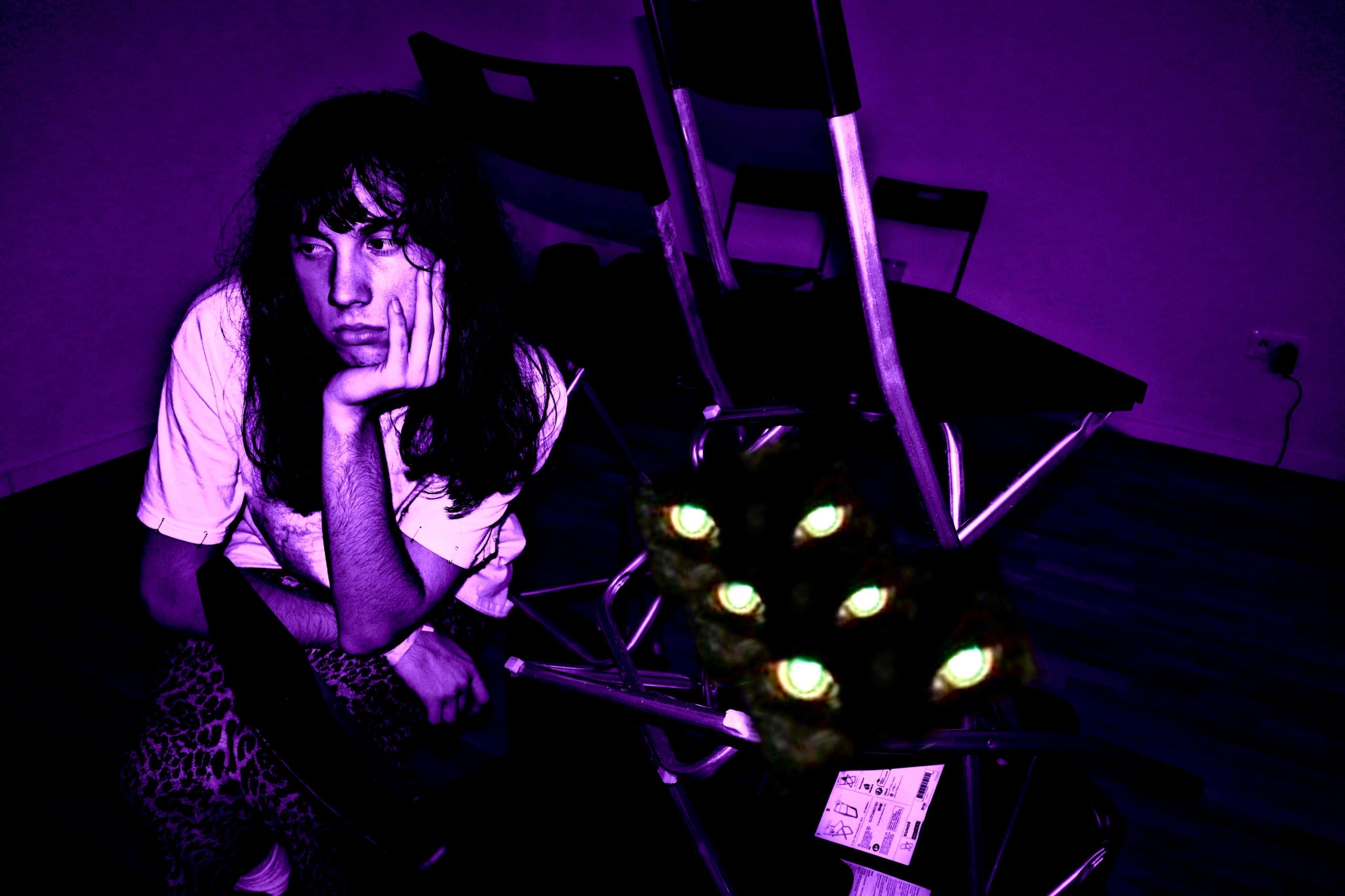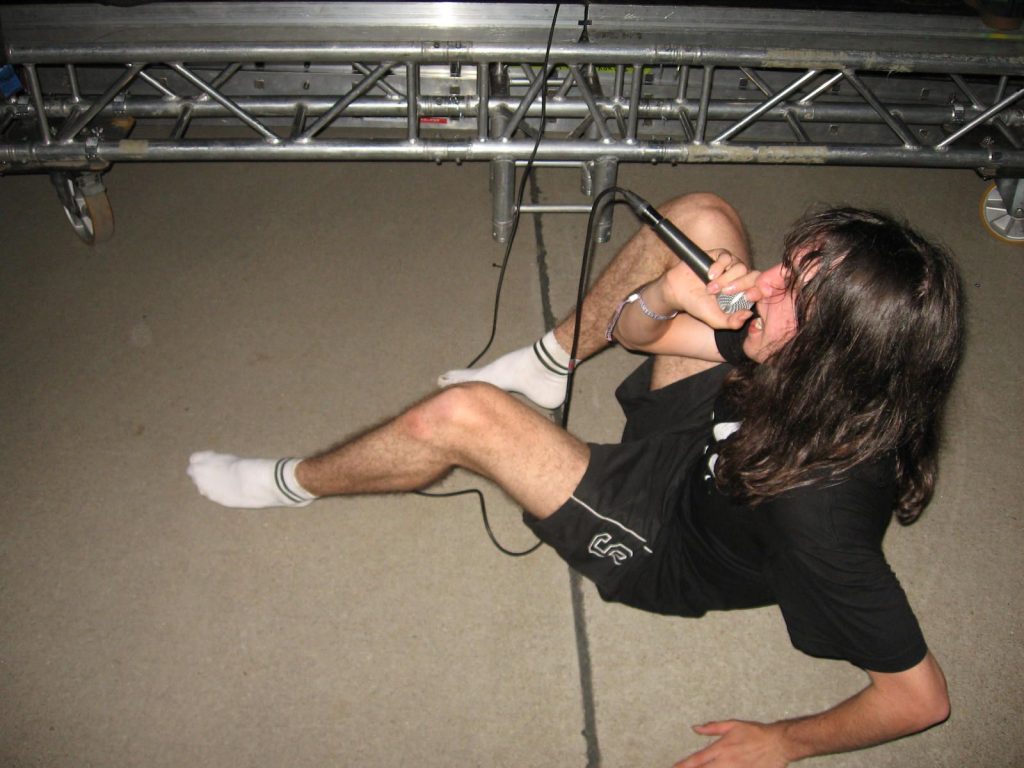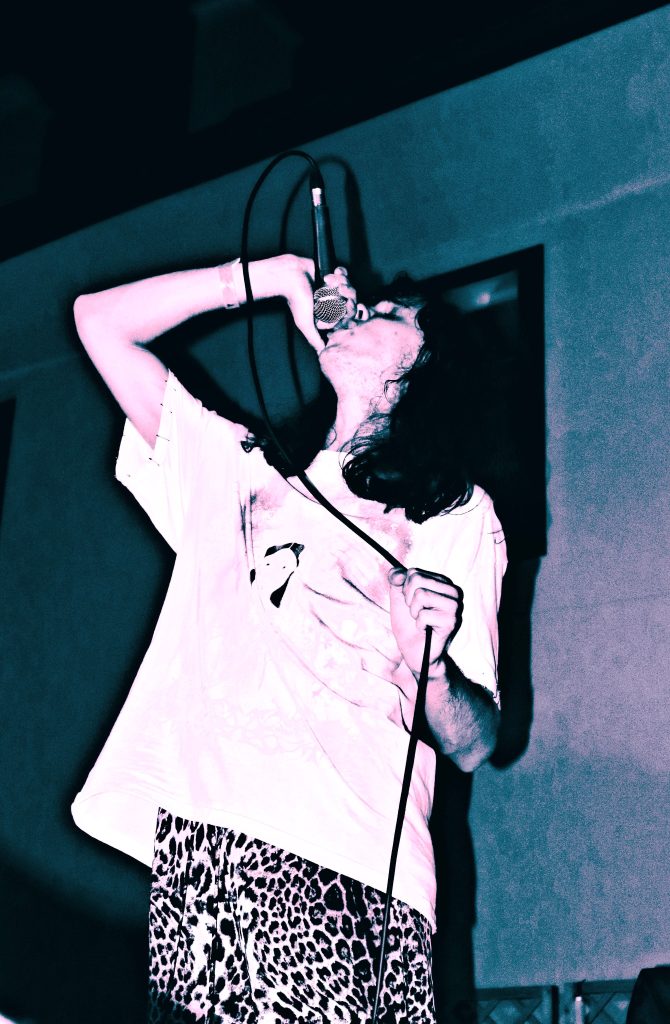Adam the World: Humanity doesn’t need hierarchy
Published April, 2025
by Easterndaze

Adam the World is a rapper and alternative R’n’B artist from Kremnica in Slovakia, currently living in Prague. His explosively diverse, syncretic work is characterized by elements of neosoul and alternative R’n’B. The lyrics of his songs stand out for their open criticism of cultural appropriation and social inequalities. At the Acropolis in Kremnica, we spoke with Adam about the meanings of humanity and love, gender dynamics in the alternative scene, and the commercial undermining of subcultural political messages.
(Originally published by 34.sk)
You are now quite openly working with left-wing thinking and feeling in your compositions and in your various outputs online. How has this perception of yours been shaped?
I am an outspoken leftist and openly agitate politically. It’s an important part of me. When I started getting into philosophy and politics, I noticed certain patterns in my experience that relate to capitalism and society in general. Over time, I realized that I am part of social issues in which I play a role. That is how I feel and why I feel it has its reasons. I am privileged in some things and through certain mechanisms, I indirectly and unintentionally oppress other groups of people. I live in a hetero-patriarchal society, I have some norms, and I also come from some normatives that have shaped me. And that’s what I notice about myself. My music is not only expression but also analysis.
Your profile on the GoOut websites defines you as an underground artist whose central theme is love. This may sound basic, but what’s interesting is that you situate love in the context of consumerism, apathy, fatigue, and misunderstanding. Can you reveal more about your understanding of love?
I can’t talk about politics and philosophy with my friends because they are interested in other things. That’s what songs are for, to analyze love as a commodity. Because love is the most common theme of the songs, or at least that’s what everybody says. But I have a different view of love. I think of it as a decision that can be subject to commodification. And it is precisely because it is such an accessible topic that I have chosen to use it to explain the relationships of emotions to the market, privilege, empire, forms of oppression, or different worldviews.

Photo: Adam Murín
How does your audience react to this analytical level of your texts?
I think sometimes I ramble a lot. My friends tell me: “God, Adam, you make such a good song and then you add a million words and make it into a four-minute ode about how much you hate the market economy.” And I say to that: “Sorry, that’s how I feel.” I often sing about a kind of humanity that I can’t quite define. I don’t have a steady sound, I’m always making collisions between soft and hard things, singing, then screaming, putting in drum breaks and hyperpop drops. With my lyrics, I try to bring people closer to their position. By seeing how I reflect on myself, maybe they can get a glimpse of their own roles. I’m also just a reflection of reflections.
You are part of the group WOC (Window of Creativity), which also includes Vrillton and Samm734, all three of you are from Kremnica. Is this regional framework important to you? On ¾ we published an interview with Vojtik, who talked about the fundamental position of Detva as a source for his work. Does Kremnica represent something similar for you?
Vojtik and I recently talked about this. I told him that I had to do more about Kremnica, as he did about Detva. I don’t mention Kremnica directly in my texts, but it is important to me, especially in terms of building community and relationships in my surroundings. I’m more introverted and reclusive, but community is still the cornerstone of everything. WOC originally had more members, they were Kremnica-based too, but that has dwindled over time. Samm734 was my classmate in elementary school and Vrillton is from second grade, but same year. We had the same mindset and defined ourselves against other groups in our class. As we grew up, our connection became stronger and stronger. During high school, I realized that home was necessary. This environment shaped me.
The first time I saw you on stage was during the Kataklyzma performance in Tabačka in Košice, where I went more or less unaware. I had no awareness of the digicore scene, which Kataklyzma was a showcase for, so I was surprised by this collective format. Can you reveal something about the planning and production of Kataklyzma?
Sugoi Kimono, Ph1l, Samm734 and myself were the core team. Thanks to Ph1l’s dad, Pal Frost, who was our manager, we put it all together. He handled all the stuff that us kids were out of the loop on. I was thinking about how to make it more than just a show, and I came up with this post-apocalyptic aesthetic. I had read Mark Fisher before making Kataklyzma and decided to connect the dots that way. Palo and I were putting it together so that the songs would also form a kind of storyline. The whole show had three acts: the opening act, then the catastrophe, and finally the act after the catastrophe. The goal was to show not only the fast-paced nature of the music but also consumerism and progress.
How did you achieve this impact?
The performance was not divided into individual sets. No one could know who was playing when. Everything was unexpected, catastrophic. At one moment there were four people with a microphone on on stage and they could say anything, while two seconds later another person was about to come on stage who we didn’t even know where he was. It all came down to small, unexpected moments. I think people felt it. We were trying to break down the barriers between the audience and what was happening on the stage.
Every show got better and better. We were adding new stuff, making t-shirts with Ph1l and working more and more with the stage design. Sometimes it was really hard to set some boundaries. I’ve even been warned not to make a spectacle out of it, it was still supposed to be primarily a show. So I had to compromise, collaboration was key. Kataklyzma was the last project and act of what we can call digicore.

Photo: Tereza Valekova
Why did digicore end?
In the beginning the artists stuck more together, but gradually they closed themselves into their catacombs. In the end, even the development of that genre fragmented. All the elements of fast digicore and other cores that were created during a certain period have completely disappeared. They’re all doing something else now and have moved on from their roots elsewhere, or rather, that root has grown. That’s why I take it as the end.
Matej Žofčín in his article for ¾ about the digicore scene compares your album I Hear Colours to Frank Ocean’s Blonde and appreciates the integrity of the work, which perhaps stands out from the more fragmented nature of the digicore scene. What do you think is the reason for that?
I’ve been in different positions. My first songs had simple trap beats, I was completely out of it. I used to be scared to express myself through singing and now, on the contrary, I primarily sing or scream. While the whole digicore scene was being created, I was doing more for others, mixing and stuff like that. When I finally started focusing on my own songs, I wanted to try something different.
Matej Žofčín also mentions how the digicore aesthetic of sound and visuals was noticed by more mainstream artists. Fobia Kid with Samm734 created Gothic Outfit and recorded the video in several Žilina locations with representatives of the digicore community. How do you see this use of underground aesthetics by mainstream artists?
We often talk about it in the community. My distinctly goth friends felt that Fobia Kid was ripping off the subculture and capitalizing on it, even though they knew nothing about it. But he just wanted to make a song, and I don’t think he plans to continue in that vein. Gothic Outfit came about naturally, Fobia Kid was authentically alive with it and educated in the subculture, I worked on the mix. It was such a hop and a skip, there wasn’t any calculation behind it. But it’s true that a lot of mainstream artists benefit from alternative, it’s a source of aesthetics and “soul” for them, they try to stay relevant that way. It’s causing the gradual disappearance of subcultures. Both their messages and their politics are disappearing, which is a real shame. Playboi Carti is also doing this on a somewhat global scale. Also in the Slovak scene, more pop-punk love songs are now in the forefront, which are also tainted by commerce. Adam Dragun [of Slovak band Berlin Manson] summed it up well in an Instagram post where he urged punk bands to stop repeating shout-outs and instead start posting their experiences of social problems.
So far I have deliberately used masculine pronouns when referring to the digicore scene, not because it is generic, but because it mirrors reality, at least I haven’t registered any female representatives of the community who would be also performers. What does this gender exclusivity say about the digicore community, is there any gatekeeping?
In the Slovak alternative scene, women are almost absent. Unfortunately, they are often used the way the whole world uses them, which is to objectify and sexualize them. Maybe it’s also the fact that an awful lot of disgusting and perverted men are active in the field of music and art in general. Women maybe feel pressured and prefer not to participate when they see how the whole system works. I have no other explanation.
Have you ever had the idea of bringing up a female performer in your circles?
I “forced” all my friends into music. But there was never an occasion that there were girls interested in what we were doing. Those 13-year-old boys who digicored seemed to associate only with themselves, and so kept a closed male society. I’m open to any collaboration, I also like the gesture [Slovak project] Eduv syn made of putting only women to collaborate with. But by always having boys around me, nothing like that has happened to me yet. My younger sister sings very well, but I guess there will be time for that later.
In bands it’s maybe more open, for example Cherries & Therapy has a great frontwoman. But it’s mainly the mainstream that’s opening up, an example is the rapper Yambro. The issue is that the mainstream is opening up in such a weird way, a woman has to be focused on the body and sexualization to be relevant.
On the other hand, there is some looseness of the gender binary in the digicore community…
The whole gender realm in the alternative and especially digicore scene is specific. There was a kind of transgression into the normativity of gender in the sense that no one was addressing gender norms, I started to meet non-binary and trans people because of that. Digicore thus created a safe environment where gender didn’t play a role. But I noticed that artists sometimes queerbait. They use feminine traits to further capitalize.
The question of entitlement and questioning one’s own needs is a recurring theme in your more recent work. Do you want to comment on why the question of the legitimacy of your needs is so important to you?
Our experience of reality is constantly changing and I am constantly trying to get to know myself. That’s why I make music. In it, I question everything from my selfishness to my privilege, and I acknowledge those traits and try to confront them. I know I’m not always good and I often have terrible wants and needs. Through music, I explore where they come from and why. By making a song about it, I make that question real. But I try to avoid self-pity. People often have only two sides: self-deception or self-pity. I try to overcome this polarity through music, which allows me to look at my needs from a broader perspective. That’s why I make everything about myself while challenging the individualism that runs through everything in society.
Questioning is essential, but sometimes you need to be affirmative. I’m reading The Joy of Fighting for a Better World by Carla Bergman right now, which is just about the fact that we all criticize each other and lack affirmative action. On the left, we are all squabbling and not addressing the real issues. I’m dealing with this not only on the level of politics and ideology, but also on a personal level. I don’t just want to point the finger at others. I’m trying to bring humanity into that pressure of mutual criticism, and I define humanity as something that doesn’t need hierarchy.
What are you working on now?
I record a lot, I can do four songs in a day. Not because I’m some productive monster, but because I’m trying to find my next direction. I want to work more and more with the steadj, I don’t want to just have pure steadj. I enjoy chairs and I want to work with them as sculptures. I’m trying to figure out new ways to engage the computer. So far it’s just been the microphone going into the mix, now I want to do more with effects and spice up the show with phrasing and intros as well. Other than that, I want to get back into other artistic practices, especially painting. I’m often sad, grumpy and tired, there are always issues I want to talk about. I don’t plan anything more, I let it go. Maybe I’ll start making songs about God.
In the summer you performed at several festivals, you were also supposed to perform at the prematurely ended [one of the largest music festivals in Slovakia where a storm of cataclysmic proportions happened during their 2024 edition] Pohoda. How do you rate your festival experience?
I was supposed to perform at Pohoda with Vrillton and my friend Sveti. A trip to McDonald’s, which I otherwise boycott, saved me and Sveťo from the storm, but Sveťo really wanted to go. When we came back, the area was already in chaos. The big tent had fallen on Vrillton, a lot of bad things had happened to a lot of people. I like how the art scene has mellowed after the storm. It was an interesting to see.
It’s great that they’re doing a lot of different festivals, not just music ones. Štiavnica Realshit showed that a bunch of young guys can make a festival. I also enjoyed 66 hodín in Smolnik, where there were little kids at my concert. At Urban Market in Bratislava I had an audience of older people. I don’t limit my work as something for the young just because I belong to the youth. I don’t think in such categories. I don’t choose the venues we play in according to any generational key either.
So who is your work for?
For everybody, except Nazis.

TEXT Dominika Moravčíková (for 34.sk)
PIC Carnifexka (Soňa Mészárošová), Tereza Váleková, Adam Murín (for 34.sk)